Seems my last snark-riddled article was quite popular! I could tell because so many critters commented on the fact that I failed to mention how my authentic Kung Pao Chicken is made. Not quite the purpose of this forum, but hey! Freedom Warriors travel on their stomachs too, so here’s a companion to my last article, Soylent Green: The Solution to the Inherent Evils of Culinary Appropriation.
Kung Pao Chicken
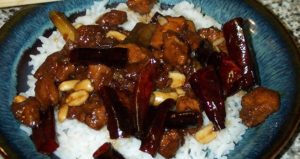
The easiest way to execute most Chinese dishes is to gather the ingredients together in bowls or ramekins prior to actual cooking. This gets all the prep work out of the way and organized ahead of time, so the cooking itself goes quickly. This is especially helpful if you are preparing multiple dishes. I once made a four dish meal for my crew at work and managed to pick all the most preparation intensive dishes without thinking. Eight hours of prep work followed by a total of twenty minutes of cooking.
I will group the various sets of ingredients together in bowls below. The ingredients as I list them will be shown in bold to make your shopping list easier, followed by how to prepare the ingredients in each set along with selection notes and other educational items.
Bowl 1
- 3 ea. Chicken Breasts
- 2 Tbs Dark Soy Sauce
- 2 Tbs Water
- 4 tsp Corn Starch
Dissolve the corn starch in a mixture of water and dark soy sauce. Chinese style dark soy sauce is generally used for cooking, while the Chinese light soy sauce is used as a condiment. I really like a brand called Healthy Boy Black Soy Sauce for cooking. Loosen the chicken breasts with a meat mallet and slice them into pieces 1/2 to 3/4 inches in size. Mix the chicken in with the other ingredients and set aside.
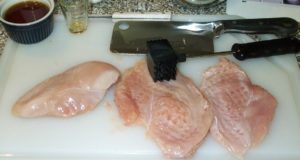
Loosened Chicken
Bowl 2
- 3/4 Cup Dried Red Pepper
- 2 tsp Sichuan Peppercorn.
The Sichuan Peppercorn I usually have to buy online from Amazon etc. It’s usually packaged in fairly large quantities, so separate the batch into small jars or vacuum pack for storage. You may have to use other spellings of Sichuan to find it online. The dried red peppers usually come from the Mexican food section of my local grocery store. They are the long, slender red ones or you can buy the very similar Chinese variety online while you’re buying the first batch of peppercorns. The thing I’ve found is, the smaller they are, the hotter they are, so you may have to scale back or increase quantity depending upon your region and source.
Slice the peppers into 3/4 to 1 inch lengths and discard the seeds. Poultry shears or a fine, serrated knife are good for this. You don’t have to get too crazy about removing all of the seeds, as long as you get most of them. Sometimes it helps to slice the pepper segment open along an edge to scrape the seeds out. What we really want is access to the interior of the pepper where the best flavors are.
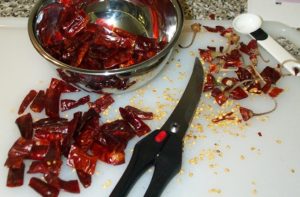
Bowl 3
- 2 bunches Green Onions
- 2 tsp Minced Ginger
- 2 tsp Minced Garlic
Discard the root ends of the onions, then slice the bottom portions into 1 to 1 1/2 inch long sections, stopping when you get to the tougher, greener portion of the onions. I love these things in this dish, so you can cut the quantity back if you want or go nuts and add more. I don’t know what the standard weight of a “bunch” of green onions is, but they usually come with several wrapped together.

Green Onions
Bowl 4
- 2 Tbs Cooking Wine (Chinese preferred but not critical)
- 2 Tbs White Vinegar
- 2 Tbs Dark Soy Sauce
- 1 Tbs Sesame Oil
- 4 tsp Sugar
- Sugar Coloring (below)
The only trick here is the Sugar Coloring, which is basically a caramelized sugar sauce. To make it, place 4 Tbs of sugar and 2 Tbs of water in a wok and simmer until it thickens and browns. This may take a little bit of practice, but the sugar will be molten after the small amount of water evaporates and it’ll brown quite readily. Once it seems like it’s on the verge of burning, add 1/2 of water and boil over high heat for three minutes, stirring to dissolve any sugar that’s turned to “candy”. Add it to the bowl of ingredients above.
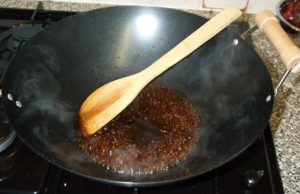
Sugar Coloring
Bowl 5 (ramekin really)
- 2 Tbs Water
- 1 tsp Corn Starch
Just mix this up real good.
Also:
- 1 Cup Peanuts
Preferably unsalted, dry roasted.
- 4 Cups Canola Oil
Or whatever
Lets Get Started
This is where everything suddenly comes together. Heat the Canola oil in a wok to 280° F. It’s probably popping and splattering already if you’ve still got residue from the Sugar Coloring prep on the bottom. Carefully dump the contents of Bowl 1 into the oil and stir until the chicken pieces are separated. Should only take a minute or two. Scoop the chicken out with some sort of scooper thing and set on some paper towels to drain.
Dump the oil out of the wok, preferably into another pot to cool. Put 3-5 Tbs of oil back in, then add the peppers and peppercorns from Bowl 2. Stir the peppers until “fragrant”, which could also result in breathing difficulties with inadequate ventilation. Don’t let them burn. Add the onions, ginger and garlic from Bowl 3 and stir fry until the outer layers of onion just begin to soften. Add the chicken and then the sauce in Bowl 4. Stir to mix, add the ramekin of corn starch solution. Heat, stirring, until good and hot, then stir in the peanuts.
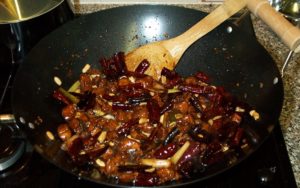
Finished! Oh, and at some point you probably should have made some rice. The Chinese will not actually bring rice until the end of the meal because it’s seen as a cheap filler and it makes your host look bad if they bring it out right away. Most westerners prefer to eat rice WITH their meals, which does tend to create a bit of conflict.
Also, in China it’s considered rude to eat everything on your plate because it makes your host think they didn’t make enough food for you. So, when your mother used to tell you that you should eat your entire meal because children were starving in China? CHILDREN IN CHINA AREN’T FINISHING THEIR MEALS!
